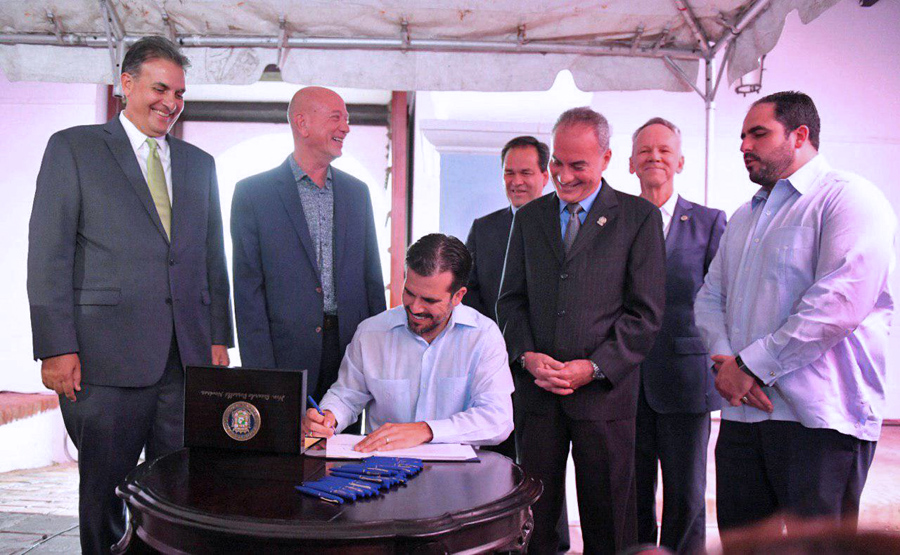New Public Energy Policy Law draws praise from sector, Oversight Board

Governor Ricardo Rosselló signed the law that will establish Puerto Rico’s public energy policy moving forward, which requires the progressive elimination of the use of fossil fuels as a source of power generation.
To this end, the Public Energy Policy Law establishes a new timeline for the implementation of renewable energy on the island: the elimination of 20 percent of fossil fuels by 2022; 40 percent by 2025; 60 percent by 2040; and 100 percent renewable energy by the year 2050.
“We have designed a regulatory framework to transform our energy system to a resilient, reliable and robust one with fair and reasonable rates for all consumers,” Rosselló said.
Rosselló added that “this new measure, together with the law for the transformation of the Puerto Rico Electric Power Authority, provides us with the necessary tools to reform the way we view energy production and consumption. We are taking an advanced step to improve the quality of life for all who reside in Puerto Rico.”
The measure provides for the modernization of the energy grid to develop a “robust, reliable, intelligent and flexible” system that can integrate new technologies and renewable energy, he said.
The new law also establishes the transfer of the operation and maintenance of the transmission and distribution of energy to a private operator through a public-private partnership on or before Dec. 31, he said.
Puerto Rico’s Electric Power Authority CEO José Ortiz Vázquez said “the low cost of solar energy and battery systems will make the implementation of this law possible, providing many options to consumers and making the energy grid more resilient.”
The signing of the law drew praise from at least one major private-sector renewable energy provider, Sunrun Inc., which “applauded Rosselló for his vision.”
“Rosselló’s approval of this transformational clean energy law marks a historic day for all Puerto Ricans,” said Sunrun CEO Lynn Jurich.
“Embracing technology like home solar and batteries will play a critical role in accomplishing these trailblazing goals, putting the people of Puerto Rico at the center of the solution with local jobs and clean, resilient, reliable, energy for homes across the island,” she said.
Meanwhile, Natalie Jaresko, executive director of the Financial Oversight and Management Board for Puerto Rico, said the new law “establishes a fair regulatory framework and is a step forward toward PREPA’s transformation.”
“With bipartisan support, the new law ensures and strengthens the role of an independent regulator and lays the ground for the diversification of fuel sources and the transition to clean energy,” she said. “More importantly, this new policy will give way to a more resilient and reliable energy system for the benefit of the people of Puerto Rico.”
The law strengthens the Puerto Rico Energy Bureau as the regulatory entity in charge of executing the implementation of the public energy policy. The Bureau’s budget will be increased to $20 million; it will be granted greater operational autonomy and will be given new regulatory powers through mechanisms based on performance metrics of energy companies.
The law also orders PREPA to transfer the generation assets through sale or P3 agreement to private companies. It also points out that no company can own 50 percent or more of the electric generation assets. The contractors that acquire or operate PREPA’s generation plants must modernize them or replace them with highly efficient plants in a period not to exceed five years.
Likewise, the new plants that are established during the transition to 100 percent renewable energy will have to be smaller-scale plants, the law mandates.
They must also have the capacity to operate with multiple fuels that minimize greenhouse gas emissions, with more modern technology and high efficiency, and with the capacity to integrate distributed generation and renewable electric power.
The new law promotes the distribution of renewable energy by establishing an absolute retail net metering for the participants of the Net Measurement Program. Under this program, a customer with an eligible generation system — which uses a renewable source of energy — can export the excess energy generated by its system to PREPA’s network.
PREPA will measure the energy that the customer exports to the network and will invoice the customer for the net energy consumed. The net energy is equal to the energy consumed by the customer minus the energy that is exported to the network.
If the customer exports more energy than they consume from PREPA, the excess will be posted to their account so that it can be used in subsequent months, the law states.
Through the Net Measurement Program, the network operator will compensate the consumer-provider for the energy that they export to the network at the same rate per kilowatt hour at which they purchase the energy.
New Green Energy Trust
The measure creates a Green Energy Trust that will promote consumers becoming consumers-suppliers. The Trust will be responsible for establishing programs or providing financial support to projects that provide access to green energy to residents of low- and middle-income communities.
The entity will also support municipal energy companies, as well as solar communities, micro-grids in isolated communities as well as those in low- and medium-income areas; it will facilitate the financing of green energy projects in small and medium-sized enterprises or micro-enterprises.
The new law mandates replacing 100% of street lighting with LED or renewable lights by 2030; and it also guarantees that no PREPA employee will lose their job as a result.





